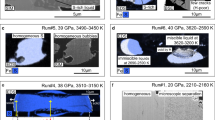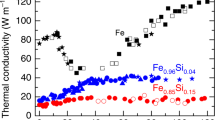Abstract
It is thought that the Earth's outer core consists mainly of liquid iron and that the convection of this metallic liquid gives rise to the Earth's magnetic field. A full understanding of this convection is hampered, however, by uncertainty regarding the viscosity of theouter core. Viscosity estimates from various sources span no less than 12 orders of magnitude1,2, and it seems unlikely that thisuncertainty will be substantially reduced by experimental measurements in the near future. Here we present dynamical first-principles simulations of liquid iron which indicate that the viscosity of iron at core temperatures and pressures is at the low end of the range of previous estimates — roughly 10 times that of typical liquid metals at ambient pressure. This estimate supports the approximation commonly made in magnetohydrodynamic models that the outer core is an inviscid fluid3,4,5 undergoing small-scale circulation and turbulent convection6, rather than large-scale global circulation.
This is a preview of subscription content, access via your institution
Access options
Subscribe to this journal
Receive 51 print issues and online access
$199.00 per year
only $3.90 per issue
Buy this article
- Purchase on Springer Link
- Instant access to full article PDF
Prices may be subject to local taxes which are calculated during checkout
Similar content being viewed by others
References
Poirier, J. P. Transport properties of liquid metals and viscosity of the Earth's core. Geophys. J. 92, 99–105 (1988).
Secco, R. A. in Mineral Physics and Crystallography: A Handbook of Physical Constants (ed. Ahrens, T.J.) 218 (American Geophysical Union, 1995).
Glatzmaier, G. A. & Roberts, P. H. Athree-dimensional self-consistent computer simulation of a geomagnetic field reversal. Nature 377, 203–209 (1995).
Buffett, B. A., Huppert, H. E., Lister, J. R. & Woods, A. W. On the thermal evolution of the Earth's core. J. Geophys. Res. 101, 7989–8006 (1996).
Merrill, R. T. & McFadden, P. L. Dynamo theory and paleomagnetism. J. Geophys. Res. 100, 317–326 (1995).
Melchior, P. The Physics of the Earth's Core (Pergamon, Oxford, 1986).
Jones, R. O. & Gunnarsson, O. The density functional formalism, its applications and prospects. Rev. Mod. Phys. 61, 689–746 (1989).
Kresse, G. & Hafner, J. Ab initio molecular dynamics for open-shell transition metals. Phys. Rev. B 48, 13115–13118 (1993).
Stixrude, L., Cohen, R. E. & Singh, D. J. Iron at high pressure: Linearized-augmented-plane-wave computations in the generalized-gradient approximation. Phys. Rev. B 50, 6442–6445 (1994).
Söderlind, P., Moriarty, J. A. & Wills, J. M. First-principles theory of iron up to earth-core pressures: Structural, vibrational, and elastic properties. Phys. Rev. B 53, 14063–14072 (1996).
Mao, H. K., Wu, Y., Chu, L. C., Shu, J. F. & Jephcoat, A. P. Compression of iron to 300 GPa and Fe0.8Ni0.2alloy to 260 GPa: Implications for composition of the core. J. Geophys. Res. 95, 21737–21742 (1990).
Car, R. & Parrinello, M. Unified approach for molecular dynamics and density-functional theory. Phys. Rev. Lett. 55, 2471–2474 (1985).
Holender, J. M., Gillan, M. J., Payne, M. C. & Simpson, A. D. The static, dynamic and electronic properties of liquid gallium studied by first-principles simulation. Phys. Rev. B 52, 967–975 (1995).
Kresse, G. & Hafner, J. Ab initio molecular-dynamics simulation of the liquid-metal-amorphous-semiconductor transition in germanium. Phys. Rev. B 49, 14251–14269 (1994).
Moroni, E., Kresse, G., Furthmüller, J. & Hafner, J. Pseudopotentials applied to magnetic Fe, Co and Ni: From atoms to solids. Phys. Rev. B (submitted).
Vanderbilt, D. Soft self-consistent pseudopotentials in a generalized eigenvalue formalism. Phys. Rev. B 41, 7892–7895 (1990).
Perdew, J. et al. Atoms, molecules, solids, and surfaces: Applications of the generalized gradient approximation for exchange and correlation. Phys. Rev. B 46, 6671–6687 (1992).
Louie, S. G., Froyen, S. & Cohen, M. L. Nonlinear ionic pseudopotentials in spin-density-functional calculations. Phys. Rev. B 26, 1738–1742 (1982).
Ahrens, T. J. (ed.) Mineral Physics and Crystallography: A Handbook of Physical Constants (American Geophysical Union, 1995).
Lonzarich, G. G. in Electrons at the Fermi Surface (ed. Springford, M.) 257 (Cambridge Univ. Press, 1980).
Anderson, O. L. The phase diagram of iron and the temperature of the inner core. J. Geomagn. Geoelectr. 45, 1235–1248 (1993).
Poirier, J. P. Introduction to the Physics of the Earth's Interior (Cambridge Univ. Press, 1991).
Anderson, W. W. & Ahrens, T. J. An equation of state for liquid iron and implications for the Earth's core. J. Geophys. Res. 99, 4273–4284 (1994).
Vočadlo, L., de Wijs, G. A., Kresse, G., Gillan, M. J. & Price, G. D. First principles calculations of crystalline and liquid iron at Earth's core conditionsin Solid-State Chemistry — New Opportunities from Computer Simulations (eds Mackrodt, W. & Catlow, R.) (Faraday Discussion No. 106, Royal Society of Chemistry, London, 1997).
Shimoji, M. & Itami, T. Atomic Transport in Liquid Metals (Trans Tech, Aedermannsdorf, 1986).
Alder, B. J., Gass, D. M. & Wainwright, T. E. The transport coefficients for a hard-sphere fluid. J. Chem. Phys. 53, 3813–3826 (1970).
Erpenbeck, J. J. & Wood, W. W. Molecular dynamics calculation of the velocity autocorrelation function: hard-sphere results. Phys. Rev. A 32, 412–422 (1985).
LeBlanc, G. E. & Secco, R. A. Viscosity of an Fe-S liquid up to 1300 °C and 5 GPa. Geophys. Res. Lett. 23, 213–216 (1996).
Anderson, D. L. Bulk attenuation in the Earth and viscosity of the core. Nature 285, 204–207 (1980).
Officer, C. B. Aconceptual model of core dynamics and the Earth's magnetic field. J. Geophys. 59, 89–97 (1986).
Acknowledgements
The simulations were run on the Cray T3D at Edinburgh Parallel Computer Centre with support from the High Performance Computing Initiative. We thank E. Moroni, J. Hafner and J.Brodholt for discussions.
Author information
Authors and Affiliations
Corresponding author
Rights and permissions
About this article
Cite this article
de Wijs, G., Kresse, G., Vočadlo, L. et al. The viscosity of liquid iron at the physical conditions of the Earth's core. Nature 392, 805–807 (1998). https://doi.org/10.1038/33905
Received:
Accepted:
Published:
Issue Date:
DOI: https://doi.org/10.1038/33905
This article is cited by
-
Ab initio determination on diffusion coefficient and viscosity of FeNi fluid under Earth’s core condition
Scientific Reports (2022)
-
Viscosity in water from first-principles and deep-neural-network simulations
npj Computational Materials (2022)
-
Determination and comparison of the electrical and thermal transport properties of BCC and FCC Fe–Ni based ternary alloys in the Earth’s inner core
Journal of Earth System Science (2022)
-
Multiscale manipulating induced flexible heterogeneous V-NiFe2O4@Ni2P electrocatalyst for efficient and durable oxygen evolution reaction
Nano Research (2022)
-
Nucleation of Y–Si–O Nano-clusters in Multi-microalloyed Nano-structured Ferritic Alloys: a First-principles Study
Acta Metallurgica Sinica (English Letters) (2021)
Comments
By submitting a comment you agree to abide by our Terms and Community Guidelines. If you find something abusive or that does not comply with our terms or guidelines please flag it as inappropriate.



